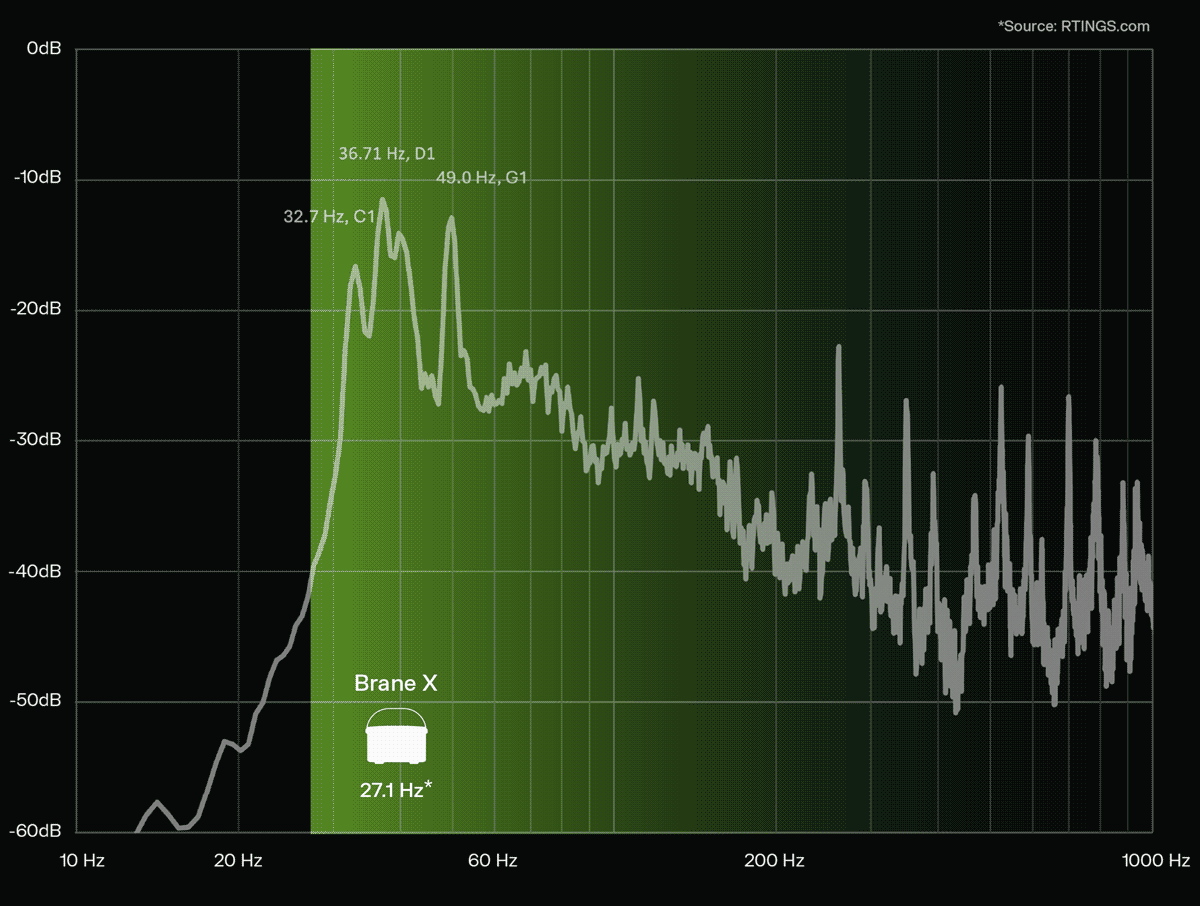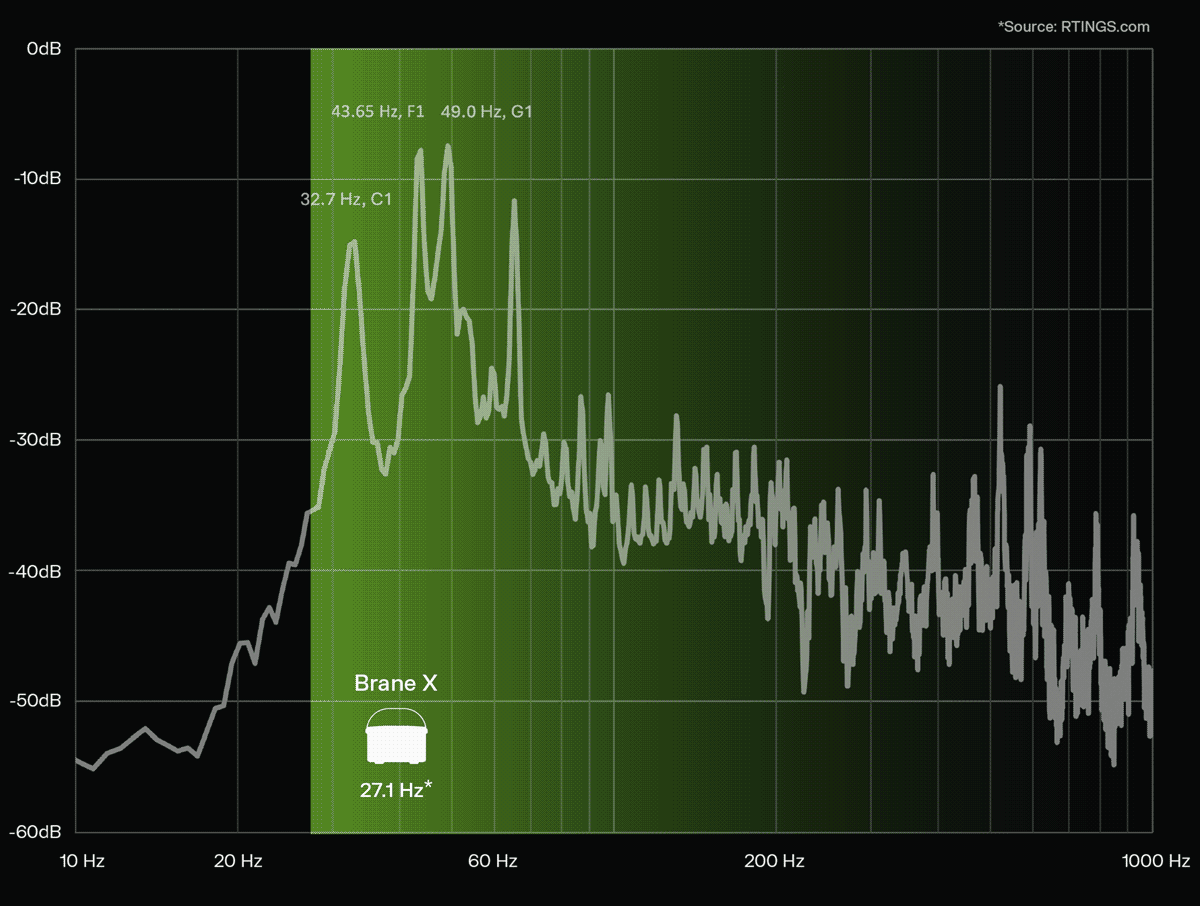Brane speakers feature custom Repel-Attract Drivers (RAD) that create audio possibilities where limitation was once the expectation.
RAD uses an array of custom magnets to cancel internal air pressure forces that inhibit deep bass in other portable speakers. This breakthrough defies the century-old audio conventions that restrict other speakers on the market. It was once commonplace that no speaker on the market could be simultaneously small, efficient, and produce room-filling deep bass—until now.

Chances are, the portable speaker you listen to your favorite song on can't reproduce over 25% of the music that the artist intended you to hear. What good is art if you can only see a fraction of the picture?
Brane X has unheard-of frequency range for a speaker its size. In a field study against other competing speakers, Brane X is the only speaker to cover almost the entirety of the sub-bass range, which falls at 20–60 Hz on the graph below.
For the audiophiles out there, Brane X hits all the way down to 27.1 Hz. Others can only strike as low as 49.7 Hz. That's over 70% of the total sub-bass notes that you're missing.
Song: Hey Now by Kendrick Lamar

Hey Now by Kendrick Lamar

Wild Ones by Jessie Murph & Jelly Roll

Monaco by Bad Bunny

God is a Woman by Ariana Grande

Lavender Haze by Taylor Swift

Wow by Post Malone

Snow on the Beach by Taylor Swift

Exes by Tate McRae

Prisoner by The Weeknd

Prior to Brane’s technology, all speakers had to obey Hofmann's Iron Law of Audio. This longstanding law states that speakers must be either large or draw a tremendous amount of electrical power to produce sub-bass. In other words, if a speaker is both energy-efficient and able to produce sub-bass, it cannot also retain a compact footprint, and vice versa.
The root cause of the Iron Law is the internal air pressure variation within a sealed speaker cabinet. Deep notes require large excursions of a speaker cone/panel as it moves in and out of its sealed enclosure. These excursions create large variations in internal air pressure that must be overcome with electrical power routed to a voice coil actuator. If the speaker enclosure is small, the required amount of electrical power is large. To reduce electrical power, the speaker enclosure size must increase to lower internal pressure variations. This power and size tradeoff has limited the performance of speakers for decades.
Brane's Repel-Attract Driver breaks the Iron Law by using a proprietary array of permanent magnets to cancel internal air pressure forces. This novel force cancellation design allows Brane speakers to be compact, efficient and capable of producing deep bass.
RAD also compensates for the higher pressure of air compression relative to air expansion using asymmetrical magnetic forces. Our research shows that RAD can be scaled up to concert-size speakers and scaled down for use in earbuds while maintaining an order of magnitude advantage in both size and power consumption.
Brane X and RAD are covered by several issued (US12,003,940B2; US12,003,941B; US12,003,942B2; US12,003,943B2; US12,126,979B2) and pending patents.

Electrostatic speakers move thin membranes between two charged plates to produce extremely detailed and directional sound. The two main drawbacks of existing electrostatic speakers are their large size and inability to reproduce bass notes. Brane's Sub-millimeter Electrostatic Membrane Array (SEMA) solves these two problems by creating membrane motion that is perpendicular to the emitted sound waves. This patented design reduces speaker size twentyfold and forms a partial baffle that enables bass notes. The required input voltage is also substantially lower due to the sub-millimeter spacing between the two charged plates.
SEMA drivers take spatial audio to the next level by beaming sound along well-defined paths and enveloping the listener in gorgeous, immersive sound. Although SEMA is not used in Brane X, expect to see it in future Brane products.
SEMA is covered by several issued (US9826313B2; US9820057B2; US9924275B2; US10250997B2; US11425506B2; US11575991B2; US11595751B2; US11134336B2; US10791401B2) and pending patents.

Conventional speakers are less than 1% efficient in large part because the membranes used to produce sound are much heavier than the air they move. A better approach is to use an advanced material called graphene to produce sound. Because a graphene membrane is just one atomic layer thick, it weighs about the same as the air it moves to produce sound.
Brane’s patented Graphene Drum Array (GDA) uses a small voltage between a graphene membrane and a metallic electrode to produce extremely detailed sound at high efficiency. GDA can be used to efficiently produce sound in small devices like earbuds using a membrane actuation signal that is directly proportional to the audio signal. When much higher sound pressure levels are required, GDA can be actuated at frequencies in the megahertz range and modulated to produce sound in the audio frequency range (similar to how a radio carrier frequency is modulated to produce lower frequency signals). This more complex version of GDA has the potential to reduce the size of a speaker by a several orders of magnitude. Although GDA is not used in Brane X, expect to see it in future Brane products.
GDA is covered by several issued (US9313580B2; US9100754B1; US9167353B2; US9353740B2) and pending patents.